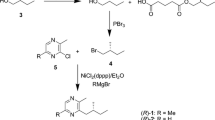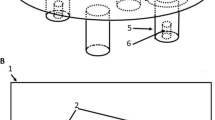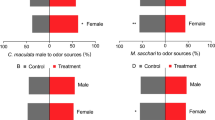Abstract
Several species of Pseudacteon phorid flies, including Pseudacteon cultellatus, P. curvatus, P. obtusus, and P. tricuspis, have been introduced in the southern United States for biological control of imported fire ants, Solenopsis spp. Previous studies showed that Pseudacteon flies use the alarm pheromone and venom alkaloids of fire ants to locate host ant workers. A recent study by our group demonstrated attraction of one of the species, P. tricuspis, to certain alkylpyrazine analogs of fire ant alarm pheromone. If effective, alkylpyrazine analogs of fire ant alarm pheromone may provide cost-efficient alternatives as phorid fly attractants. To test the hypothesis that other phorid fly species are attracted to alkylpyrazine analogs of fire ant alarm pheromone, we compared electroantennogram (EAG) and behavioral responses of four Pseudacteon species, P. cultellatus, P. curvatus, P. obtusus, and P. tricuspis, to the commercially available alarm pheromone isomer (2-ethyl-3,6(or 5)-dimethyl pyrazine) and six structurally related alkylpyrazine analogs at physiologically relevant doses (ranging from picogram to 10 µg). The alarm pheromone isomer and two analogs, 2,3-diethyl-5-methyl pyrazine and 2 ethyl-3,5 + 6 methyl pyrazine, elicited the strongest EAG activity in all four species at all tested doses. Results from four-choice olfactometer bioassays testing the above three EAG-active compounds showed that all four species were strongly attracted to the alarm pheromone isomer at doses ranging from 0.001 to 1 µg. The flies also showed significant attraction to the two analogs (2,3-diethyl-5-methyl pyrazine and 2 ethyl-3,5 + 6 methyl pyrazine) compared to the solvent control but not as strong as the attraction elicited by the alarm pheromone isomer. These results confirm that multiple species of phorid flies use fire ant alarm pheromone as a host location cue. However, the flies are not strongly attracted to the tested alkylpyrazine analogs of the alarm pheromone.


Similar content being viewed by others
References
Billen J, Morgan ED (1998) Pheromone communication in social insects: sources and secretions. In: Vander Meer RK, Breed MD, Espelie KE, Winston ML (eds) Pheromone communication in social insects ants, wasps, bees, and termites. Westview, Boulde, pp 3–33
Cavill GWK, Houghton E (1974) Some pyrazine derivatives from the argentine ant, Iridomyrmex humilis. Aust J Chem 27:879–889
Chen L, Fadamiro HY (2007) Behavioral and electroantennogram responses of phorid fly Pseudacteon tricuspis (Diptera: Phoridae) to red imported fire ant, Solenopsis invicta odor and trail pheromone. J Insect Behav 20:267–287
Chen L, Sharma KR, Fadamiro HY (2009) Fire ant venom alkaloids act as key attractants for the parasitic phorid fly, Pseudacteon tricuspis (Diptera: Phoridae). Naturwissenschaften 96:1421–1429
Chen L, Ochieng S, He X, Fadamiro HY (2012) Comparing electroantennogram and behavioral responses of two Pseudacteon phorid fly species to body extracts of black, red, and hybrid imported fire ants, Solenopsis spp. J Insect Physiol 58:1360–1367
Gilbert LE, Morrison LW (1997) Patterns of host specificity in Pseudacteon parasitoid flies (Diptera, Phoridae) that attack Solenopsis fire ants (Hymenoptera: Formicidae). Environ Entomol 26:1149–1154
Graham LCF, Porter SD, Pereira RM, Dorough HD, Kelley AT (2003) Field releases of the decapitating fly Pseudacteon curvatus (diptera: phoridae) for control of imported fire ants (Hymenoptera: Formicidae) in Alabama, Florida, and Tennessee. Florida Entomol 86:334–339
Longhurst C, Baker R, Howse PE, Speed W (1978) Alkylpyrazines in ponerine ants: their presence in three genera, and caste specific behavioral responses to them in Odontomachus troglodytes. J Insect Physiol 24:833–837
Morrison LW, King JR (2004) Host location behavior in a parasitoid of imported fire ants. J Insect Behav 17:367–383
Morrison LW, Porter SD (2006) Post-release host-specificity testing of Pseudacteon tricuspis, a phorid parasitoid of Solenopsis invicta fire ants. Biocontrol 51:195–205
Patrock RJW, Porter SD, Gilbert LE, Folgarait PJ (2009) Distributional patterns of Pseudacteon associated with the Solenopsis saevissima complex in South America. J Insect Sci 9:17
Pesquero MA, Campiolo S, Fowler HG, Porter SD (1996) Diurnal patterns of ovipositional activity in two Pseudacteon fly parasitoids (Diptera: Phoridae) of Solenopsis fire ants (Hymenoptera: Formicidae). Florida Entomol 79:455–457
Plowes RM, Lebrun EG, Gilbert LE (2011) Introduction of the fire ant decapitating fly Pseudacteon obtusus in the United States: factors influencing establishment in Texas. Biocontrol 56:295–304
Porter SD, Alonso LE (1999) Host specificity of fire ant decapitating flies (Diptera: Phoridae) in laboratory oviposition tests. J Econ Entomol 92:110–114
Porter SD, Calcaterra LA (2013) Dispersal and competitive impacts of a third fire ant decapitating fly (Pseudacteon obtusus) established in North Central Florida. Biol Control 64:66–74
Porter SD, Gilbert LE (2004) Assessing host specificity and field release potential of fire ant decapitating flies (Phoridae: Pseudacteon). In: Van Driesche RG, Murray T, Reardon R (eds) Assessing host ranges for parasitoids and predators used for classical biological control: A guide to best practice. FHTET- 2004-03, USDA forest service, Morgantown, pp 152–176
Porter SD, Pesquero MA (2001) Illustrated key to Pseudacteon decapitating flies (Diptera: Phoridae) that attack Solenopsis saevissima complex fire ants in South America. Florida Entomol 84:691–699
Porter SD, Pesquero MA, Campiolo S, Fowler HG (1995) Growth and development of Pseudacteon phorid fly maggots (Diptera: Phoridae) in the heads of Solenopsis fire ant workers (Hymenoptera: Formicidae). Environ Entomol 24:475–479
Porter SD, Nogueira de Sa LA, Morrison LW (2004) Establishment and dispersal of the fire ant decapitating fly Pseudacteon tricuspis in North Florida. Biol Control 29:179–188
Regnier FE, Wilson EO (1968) The alarm-defense system of the ant Acanthomyops claviger. J Insect Physiol 14:955–970
SAS Institute (2007) JMP 7.0.1. Cary, NC, USA
Sharma KR, Fadamiro HY (2013) Fire ant alarm pheromone and venom alkaloids act in concert to attract parasitic phorid flies, Pseudacteon spp. J Insect Physiol 59:1119–1124
Sharma KR, Vander Meer RK, Fadamiro HY (2011) Phorid fly, Pseudacteon tricuspis, response to alkylpyrazine analogs of a fire ant, Solenopsis invicta, alarm pheromone. J Insect Physiol 57:939–944
Showalter DN, Troyer EJ, Aklu M, Jang EB, Sideburst MS (2010) Alkylpyrazines: alarm pheromone components of the little fire ant, Wasmannia auropunctata (Roger) (Hymenoptera, Formicidae). Insect Soc 57:223–232
Tentschert J, Bestmann HJ, Holldobler B, Heinze J (2000) 2,3-Dimethyl-5-(2(-propyl) pyrazine), a trail pheromone component of Eutetramorium mocquerysi Emery (1899) (Hymenoptera: Formicidae). Naturwissenschaften 87:377–380
Vander Meer RK, Porter SD (2002) Fire ant, Solenopsis invicta, worker alarm pheromones attract Pseudacteon phorid flies. In: Proceedings of the 2002 imported fire ant conference, Athens, pp 77–80
Vander Meer RK, Lofgren CS, Alvarez FM (1985) Biochemical evidence for hybridization in fire ants. Florida Entomol 68:501–506
Vander Meer RK, Preston CA, Choi MY (2010) Isolation of a pyrazine alarm pheromone component from the fire ant, Solenopsis invicta. J Chem Ecol 36:163–170
Vazquez RJ, Porter SD, Briano JA (2006) Field release and establishment of the decapitating fly Pseudacteon curvatus on red imported fire ants in Florida. Biocontrol 51:207–216
Wilson EO (1958) A chemical releaser of alarm and digging behavior in the ant Pogonomyrmex badius (Latreille). Psyche 65:41–51
Acknowledgements
We thank Amy Bass (USDA-APHIS-PPQ-CPHST Laboratory/Florida DPI, Gainesville, FL, USA) for the supply of Pseudacteon phorid flies for this study, and Olufemi Ajayi for help with rearing and separating parasitoids.
Author information
Authors and Affiliations
Corresponding author
Additional information
Handling Editor: Paulo H G Zarbin.
Rights and permissions
About this article
Cite this article
Ngumbi, E., Fadamiro, H. Comparative responses of four Pseudacteon phorid fly species to host fire ant alarm pheromone and analogs. Chemoecology 25, 85–92 (2015). https://doi.org/10.1007/s00049-014-0178-x
Received:
Accepted:
Published:
Issue Date:
DOI: https://doi.org/10.1007/s00049-014-0178-x




